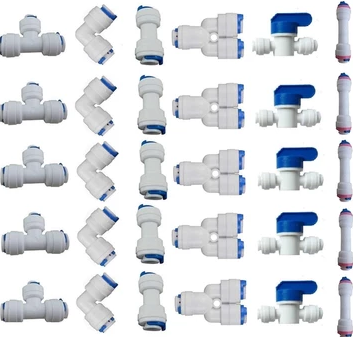Pneumatic control systems are an economical and effective choice for designing commercial buildings. They’re powered by compressed air, and are inherently analog, which makes them ideal for controlling humidity, temperature and pressure.
Push to connect air fittings
How Do They Work?
Pneumatic controls were widely used as a method of controlling compressed air in HVAC systems. The compressed air is carried from a controller to a separate control device via plastic and copper tubes. Usually, these control devices are valve actuators and dampers.
The control method relies on thermostats and sensors that retain or bleed the line pressure all the way from sensors, to control device, and finally the actuators. The sensors respond to humidity, temperature and static pressure, thereby providing a feedback loop that opens or closes the actuator in order to meet the set-point.
Pneumatic control systems actually use compressed air as a communication method. The actuators spring to function in sync with the control signal.
In commercial buildings, thermostats have pneumatic control systems that are connected to a main source of compressed air in addition to a final device—like a valve.

A push to connect air flow control valve
Benefits of Using Pneumatic Controls
Pneumatic systems are far more reliable and safe since they use air as the control medium. You can always use air-driven controls in any situation where you would otherwise use an electric control.
Let’s look at some benefits of using pneumatic controls:
- Pneumatic controls respond to changing conditions by either raising or lowering the pressure level in an airline.
- Pneumatic thermostats provide functions similar to a traditional thermostat, albeit they use compressed air.
- Similar to electronic switches that turn power devices on or off, pneumatic valves and switches turn parts of air circuits on or off.
- Pneumatic controls can determine a system’s air pressure using sensing probes.
Pneumatic Actuators
Pneumatic actuators are “air-powered” motors that are used to control dampers and control valves. Not only are they durable, economical and reliable, they don’t require any maintenance except for adjustment and inspection of mechanical linkages.
The best part is that pneumatic actuators, no matter what size, cost a lot less than electric actuators.
Modular Control Components
As discussed earlier, the complete pneumatic control system is distributed throughout a building via receiver controllers, thermostats and pneumatic relays.
What’s more is that a custom-designed pneumatic control system can deliver virtually any and every control strategy. They maintain accurate set-points and provide excellent performance.
Pneumatic Equipment That Suit All Your Needs
At Utah Pneumatic, we offer a wide range of pneumatic fittings that meet your budget and requirements, including push to connect air fittings, air filter regulator, nylon air line fittings and ball valves.
Get in touch with us today for more details!




Leave a comment
This site is protected by hCaptcha and the hCaptcha Privacy Policy and Terms of Service apply.